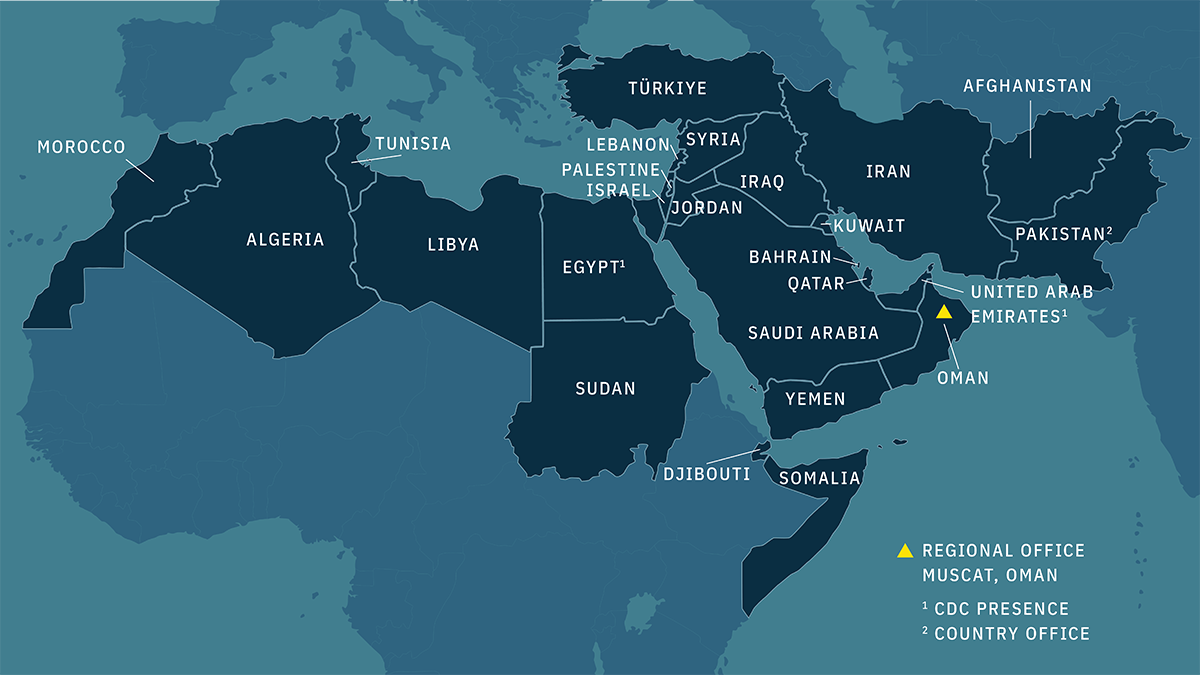CDC’s Middle East/North Africa Regional Office

Note: This map and country list displays countries covered in the Middle East/North Africa geographic region. CDC engagement is only in countries with established U.S. diplomatic relations.
At a glance
Established in 2020, U.S. CDC’s Middle East / North Africa (MENA) Regional Office, located in Muscat, Oman, strengthens and expands CDC’s historically limited footprint in the region. U.S. CDC aims to advance regional health security, strengthen health diplomacy, and is working with regional partners to prepare for and respond to broad public health priorities and health threats.
Overview
The MENA region is home to more than 879 million people and spans across 25 countries where over 22 languages are spoken. Historically, CDC had limited presence in the region, with activities focused on special populations or program specific activities.
Today, CDC’s presence in the region includes the MENA Regional Office established in 2020 in Muscat, Oman, a country office in Pakistan, and technical experts based in the region.
In recent years, CDC has supported the establishment of several new National Public Health Institutes in the region and expansion of the Field Epidemiology Training Program to additional countries. CDC has also supported laboratory strengthening activities such as the Global Laboratory Leadership Program, and regional trainings to strengthen laboratory capacities, workforce development, and preparedness and response.
The MENA region is diverse socially, politically, and economically. Public health capacities in the region also differ from country to country. The establishment of the MENA Regional Office has strengthened health diplomacy efforts in the region and better positions CDC to work collaboratively with host countries and partners in the region to prepare for and respond to broad public health priorities and public health threats in the region.
In addition to personnel in the region, subject matter experts at CDC headquarters in Atlanta, GA, provide technical support to these offices, as well as to partners across the region.
Key areas of focus
Reflecting U.S. CDC’s Global Health Strategy, CDC MENA is focused on responding to health threats in the region by building core public health capacities in:
- Workforce development
- Emergency preparedness and response
- Public health surveillance and data systems
- Migration health
- Laboratory systems
- One Health, including Antimicrobial Resistance
- Immunization systems, Vaccine Planning, and priority vaccine-preventable disease elimination
- Emerging and Re-Emerging Disease Threats
- Afghanistan
- Algeria
- Bahrain
- Djibouti
- Egypt*
- Iran
- Iraq
- Israel
- Jordan
- Kuwait
- Lebanon
- Libya
- Morocco
- Oman
- Pakistan**
- Palestine
- Qatar
- Saudi Arabia
- Somalia
- South Sudan
- Syria
- Tunisia
- Türkiye
- United Arab Emirates*
- Yemen
* CDC Presence
** Country Office
U.S. CDC and partners are collaborating to:
- Strengthen partnerships with defined roles and expectations for engagement.
- Increase opportunities for public health collaboration.
- Develop a capable, flexible, and responsive regional public health workforce.
- Enhance capacity of governments to effectively manage and respond to public health emergencies.
- Strengthen regional capacity to address priority public health concerns.
- Strengthen laboratory capacity and support.
- Support responsive and reliable surveillance systems.
- Develop evidence-based public health policies, guidance, and recommendations.
- Decrease prevalence of vaccine preventable diseases.
- Work to eliminate diseases of public health importance.
- Leverage health diplomacy initiative to promote peace in the region.